Tetragma gei
Olle PellmyrAdult Characteristics
Wing expanse 11-17 mm, with both sexes almost entirely pale ochreous or creamy white. The female possess a much elongated, telescoping abdomen used in reaching the deeply recessed ovaries of its host, Geum triflorum; the elongated seventh segment quickly loses its scales, and the exposed dark integument becomes another prominent feature of this species.
Comparison with Similar Species
The exceptionally telescoping abdomen of the female makes them unmistakable. The male is superficially similar to the somes co-occurring Greya subalba. It differs by having light tan or cream-colored forewings, whereas G. subalba has white forewings. The species is also usually found in immediate vicinity of its host, Geum triflorum, whereas G. subalba is found around members of Lomatium.
Host, Oviposition, and Larval Feeding Habits
Exclusively on Geum triflorum (mountain avens; Rosaceae). Early-instar larvae feed inside the developing seeds. An oviposition sequence, an egg, and an attacked Geum seed are shown in Davis et al. (1992)

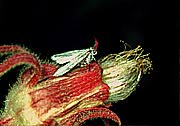
Tetragma ovipositing into a Geum flower. Ovipositor reaches ovaries at the base of the flower (at red-tan transition on calyx).
Geographic Distribution
T. gei is so far only known from Washington, Idaho, Wyoming (Yellowstone), and South Dakota (Black Hills). The host plant is more widespread, however, and the moth may well occur over a larger geographic range.
Habitat
In herb-rich steppe and forest openings with Geum triflorum, often at 1000+ m elevation. The photograph below shows the type locality, where the moth coexists with Greya subalba.

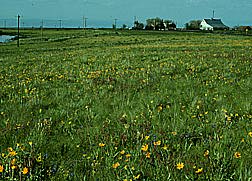
References
Davis, D.R., O. Pellmyr & J.N. Thompson. 1992. Biology and systematics of Greya Busck and Tetragma n. gen. (Lepidoptera: Prodoxidae). Smiths. Contrib. Zool. 524:1-88.
Title Illustrations

| Scientific Name | Tetragma gei |
|---|---|
| Location | U.S.A.: Washington: Asotin Co |
| Specimen Condition | Dead Specimen |
| Sex | Male |
| Image Use |
 This media file is licensed under the Creative Commons Attribution-NonCommercial License - Version 3.0. This media file is licensed under the Creative Commons Attribution-NonCommercial License - Version 3.0.
|
| Copyright |
© 1996
Olle Pellmyr

|
| Scientific Name | Tetragma gei |
|---|---|
| Location | U.S.A.: Washington: Asotin Co |
| Specimen Condition | Dead Specimen |
| Sex | Female |
| Image Use |
 This media file is licensed under the Creative Commons Attribution-NonCommercial License - Version 3.0. This media file is licensed under the Creative Commons Attribution-NonCommercial License - Version 3.0.
|
| Copyright |
© 1996
Olle Pellmyr

|
About This Page
Olle Pellmyr

University of Idaho, Moscow, Idaho, USA
Page copyright © 1996 Olle Pellmyr
 Page: Tree of Life
Tetragma gei .
Authored by
Olle Pellmyr.
The TEXT of this page is licensed under the
Creative Commons Attribution-NonCommercial License - Version 3.0. Note that images and other media
featured on this page are each governed by their own license, and they may or may not be available
for reuse. Click on an image or a media link to access the media data window, which provides the
relevant licensing information. For the general terms and conditions of ToL material reuse and
redistribution, please see the Tree of Life Copyright
Policies.
Page: Tree of Life
Tetragma gei .
Authored by
Olle Pellmyr.
The TEXT of this page is licensed under the
Creative Commons Attribution-NonCommercial License - Version 3.0. Note that images and other media
featured on this page are each governed by their own license, and they may or may not be available
for reuse. Click on an image or a media link to access the media data window, which provides the
relevant licensing information. For the general terms and conditions of ToL material reuse and
redistribution, please see the Tree of Life Copyright
Policies.
Citing this page:
Pellmyr, Olle. 1996. Tetragma gei . Version 01 January 1996 (under construction). http://tolweb.org/Tetragma_gei/12412/1996.01.01 in The Tree of Life Web Project, http://tolweb.org/




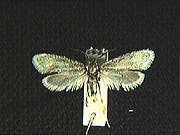
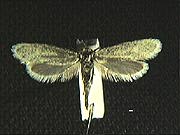

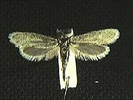


 Go to quick links
Go to quick search
Go to navigation for this section of the ToL site
Go to detailed links for the ToL site
Go to quick links
Go to quick search
Go to navigation for this section of the ToL site
Go to detailed links for the ToL site